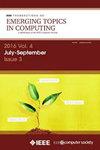q点:用极形式复数进行量子电路模拟的数字格式
IF 5.4
2区 计算机科学
Q1 COMPUTER SCIENCE, INFORMATION SYSTEMS
IEEE Transactions on Emerging Topics in Computing
Pub Date : 2025-03-30
DOI:10.1109/TETC.2025.3572935
引用次数: 0
摘要
量子电路仿真在当前量子计算时代起着至关重要的作用。然而,量子电路模拟面临着巨大的内存需求,根据量子位的数量呈指数级增长。我们的观察表明,使用实值和虚值的传统复数表示增加了内存开销,超出了模拟量子态的固有成本。相反,使用复数的半径和相位值可以更好地反映量子电路模拟中使用的复数值的性质,从而提供更好的存储效率。本文提出了q-Point,一种用于量子电路模拟的紧凑数字格式,它利用极坐标形式表示代替矩形形式表示来存储复数。提出的q点格式由三个字段组成:i)半径值的指数位;ii)半径值的尾数位;iii)相位值的尾数位。然而,对q-Point格式的幼稚应用可能会导致仿真精度和仿真速度的问题。为了使用更少的比特来保持仿真精度,我们使用了一种多级编码方案,该方案根据指数范围使用不同的尾数比特。此外,为了防止由于极坐标形式的复数的加法操作可能导致的速度减慢,我们使用了一种自适应地应用极坐标和矩形形式的技术。有了这些优化,建议的q-Point格式显示出合理的模拟精度,而使用基线格式只使用一半的内存需求。此外,q-Point格式使QAOA和VQE基准电路的模拟速度平均提高1.37倍和1.16倍。本文章由计算机程序翻译,如有差异,请以英文原文为准。
q-Point: A Numeric Format for Quantum Circuit Simulation Using Polar Form Complex Numbers
Quantum circuit simulation is playing a critical role in the current era of quantum computing. However, quantum circuit simulation suffers from huge memory requirements that scale exponentially according to the number of qubits. Our observation reveals that the conventional complex number representation using real and imaginary values adds to the memory overhead beyond the intrinsic cost of simulating quantum states. Instead, using the radius and phase value of a complex number better reflects the properties of the complex values used in the quantum circuit simulation providing better memory efficiency. This paper proposes q-Point, a compact numeric format for quantum circuit simulation that utilizes polar form representation instead of rectangular form representation to store complex numbers. The proposed q-Point format consists of three fields: i) exponent bits for radius value ii) mantissa bits for radius value iii) mantissa bits for phase value. However, a naive application of the q-Point format has the potential to cause issues with both simulation accuracy and simulation speed. To preserve simulation accuracy with fewer bits, we use a multi-level encoding scheme that employs different mantissa bits depending on the exponent range. Additionally, to prevent possible slowdown due to the add operation in polar form complex numbers, we use a technique that adaptively applies both polar and rectangular forms. Equipped with these optimizations, the proposed q-Point format demonstrates reasonable simulation accuracy while using only half of the memory requirement using the baseline format. Additionally, the q-Point format enables an average of 1.37× and 1.16× faster simulation for QAOA and VQE benchmark circuits.
求助全文
通过发布文献求助,成功后即可免费获取论文全文。
去求助
来源期刊

IEEE Transactions on Emerging Topics in Computing
Computer Science-Computer Science (miscellaneous)
CiteScore
12.10
自引率
5.10%
发文量
113
期刊介绍:
IEEE Transactions on Emerging Topics in Computing publishes papers on emerging aspects of computer science, computing technology, and computing applications not currently covered by other IEEE Computer Society Transactions. Some examples of emerging topics in computing include: IT for Green, Synthetic and organic computing structures and systems, Advanced analytics, Social/occupational computing, Location-based/client computer systems, Morphic computer design, Electronic game systems, & Health-care IT.
 求助内容:
求助内容: 应助结果提醒方式:
应助结果提醒方式:


